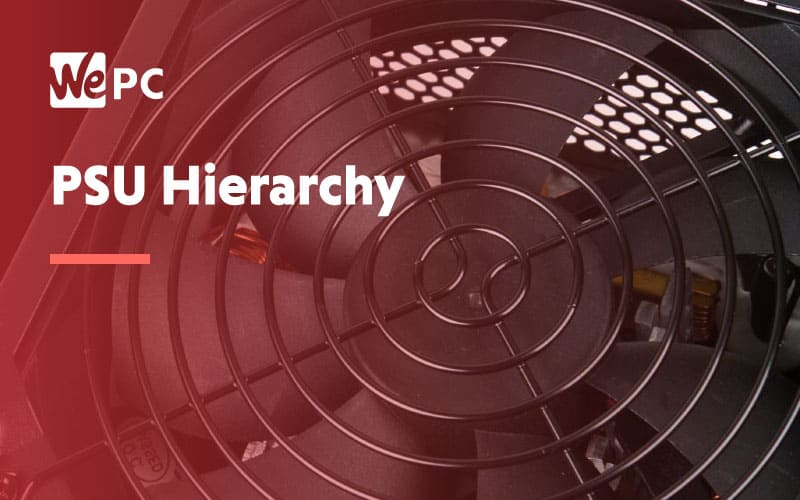If like us, you enjoy spending your weekend sifting through hardware lists in the hope of finding new and exotic options, then you’re going to love this article. We’ve decided to put together what we believe is the definitive PSU hierarchy. I know, exciting stuff.
We split the list into specific tiers which have differing levels of efficiency, safety, and power output. We start with the most sought-after power supplies and work our way down to the most budget, last-resort options.
We will continuously be updating this list when future PSUs hit shelves. So, keep your eyes on this to see how new hardware options fair against the old firm.
What does PSU stand for?
PSU stands for power supply unit and pretty much does exactly what it says on the tin. It is the component that draws power from your wall socket and feeds that power to the rest of your system. Each component of your build is connected to the PSU – or a component which is – and gets its power from it.
Understanding the ratings
A question that we get all the time is; what are the PSU ratings and how important are they?
It’s a great question because not many people fully understand the importance of PSU ratings or what they even refer to. We do have a full article on the topic which you can find here. But for those wanting a short answer, PSU rating refers to how safe and efficient a PSU is.
By efficient, we mean how much power the PSU draws from the wall compared to how much power it gives you computer.
For example; if a PSU draws 650W from the wall, but only gives your computer 400W of power, that PSU is not very efficient. It also references to how safe the PSU is. A Titanium tier PSU is less likely to malfunction when compared with an 80+ bronze, for example.
Ultimately, the rating of your PSU is pretty important and something that should certainly be considered before any purchase.
PSU Hierarchy
Below is the complete PSU hierarchy. We have categorized all the power supplies into Tier’s to make comparing different options easier.
Let’s start from the best of the best:
Power supply units that fall under the Tier A+/A are by far the most reliable and power-efficient PSU’s on this list. Almost all the PSUs in this tier have been rated at 80+ platinum or titanium. They all have excellent features, wattage range and build quality that reflects there impressive price tags.
Tier A+/A
[table id=133 /]Dropping down to B Tier will still get you a bunch of power supply options with excellent wattage outputs and superb reliability. You will also experience a decent drop in price as well. Whereas the Tier A+/A PSUs are more suited to PC enthusiasts that run several GPUs, the Tier B PSU’s are more suited to top-level gaming computers.
If you’re looking to build a decent gaming rig with several high-end components, then a Tier B PSU could be the one for you.
[table id=135 /]Tier B
[table id=136 /]Tier D
[table id=137 /]Tier C
Tier C PSUs lend themselves more towards the majority of the mainstream gamers who want a functional build with reliable components. PSUs in this tier offer decent wattage, good power efficiency, and are affordably priced.
When we get to Tier D, we start to approach the lesser recommended, yet still usable, power supplies that currently occupy the market. These PSUs fall under the “working but not offering any features” bracket.
The efficiency levels of these PSUs naturally takes a hit, but nothing too crazy. PSUs in this tier would still serve their purpose, however, they aren’t anywhere near as desirable as other options above.
Tier E
We finally come to Tier E, or what I like to call, the buy at your own risk section. This is where all the budget PSU’s can be found.
If you’re a PC enthusiast or gamer, these PSU’s will no doubt give you cold sweats just looking at them. You aren’t necessarily taking a huge risk by opting for one of these, but you are handcuffing what components and abilities your build will be able to achieve.
For me, I’d steer well clear. But here they are anyway!
[table id=138 /]Final Words
There you have it, the complete PSU hierarchy in all its glory. Choosing the right one for your needs can be a tricky process, but hopefully, this list will make that task a little bit easier.
A few things to keep in mind when looking at buying a new PSU are as follows:
- Think about reliability
- Think about Power efficiency
- Think about Safety
- Think about Cost
Answering these questions before looking for a new PSU will make the whole process a lot easier in the end.
Have we missed out any power supply’s that you feel are worthy of our hierarchy? If so, leave us a comment in the section below and we’ll add it to the list!
We have created a PSU Calculator tool that helps find the perfect PSU for your setup.

